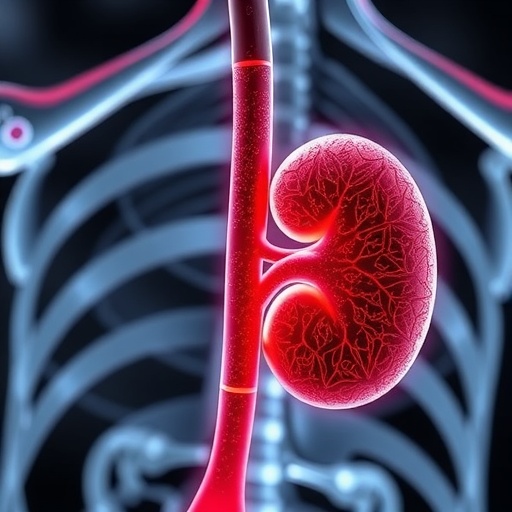In a revolutionary study that promises to reshape the clinical approach to sepsis-related kidney injuries, researchers have unveiled the potential of fenofibrate as a therapeutic agent. This groundbreaking research, conducted by a team led by Zeng et al., explores the drug’s efficacy in alleviating acute kidney injury, a serious complication that can arise during sepsis. The findings, published in BMC Pharmacology and Toxicology, highlight how fenofibrate enhances renal fatty acid oxidation, pointing to a novel intervention pathway that could redefine patient outcomes.
Acute kidney injury (AKI) is a common and dangerous complication associated with sepsis, a life-threatening condition triggered by the body’s response to infection. The incidence of AKI in sepsis patients is staggering, with studies estimating that up to 50% of such patients can experience kidney impairment. Despite advances in medical care, the mortality rates associated with AKI in septic patients remain critically high. Consequently, investing in research aimed at finding effective treatments is essential.
Fenofibrate, primarily used to treat hyperlipidemia, belongs to a class of medications known as fibrates. These agents work by activating peroxisome proliferator-activated receptors (PPARs), particularly PPAR-alpha. This activation leads to enhanced fatty acid oxidation, decreased triglyceride levels, and improved lipid profiles. The study by Zeng and colleagues takes this established mechanism and applies it to AKI in sepsis, proposing that fenofibrate’s properties can ameliorate kidney damage in these cases.
The researchers employed both in vitro and in vivo models to conduct their experiments. In cellular models simulating sepsis-induced acute kidney injury, fenofibrate treatment significantly reduced markers of cellular stress and apoptosis. This finding is vital, as it indicates that fenofibrate not only protects kidney cells from injury but also promotes their recovery. This cellular protection mechanism is crucial, given that the preservation of renal function can drastically improve the survival and quality of life for patients battling sepsis.
Results from the animal studies corroborated the findings seen in vitro. In murine models of sepsis-induced AKI, renal function parameters, including serum creatinine levels and urine output, improved significantly with fenofibrate administration. Moreover, histological examinations of the kidneys revealed less tubular structural damage, suggesting that fenofibrate exerts a protective effect at the tissue level as well, reducing inflammation and cellular necrosis.
The mechanism behind fenofibrate’s protective effects appears to hinge upon its ability to enhance fatty acid oxidation within renal tissues. In the context of renal injury and metabolic stress, fatty acids serve as alternative energy substrates for renal cells, particularly during conditions where glucose metabolism is compromised. By promoting this shift toward fatty acid metabolism, fenofibrate enables kidney cells to maintain ATP production and vital functions that would otherwise falter under stress.
Furthermore, the study reveals another critical aspect: fenofibrate may positively affect inflammatory responses associated with sepsis. Severe sepsis is characterized by an overwhelming immune response, leading to organ dysfunction and failure. By modulating inflammatory pathways linked to acute kidney injury, fenofibrate could mitigate the exaggerated inflammatory response, thus preserving renal integrity and function.
The implications of these findings extend beyond the lab and hold promise for clinical applications. As sepsis continues to pose significant challenges in intensive care settings, the introduction of fenofibrate as a therapeutic option could revolutionize the management of septic patients with acute kidney injury. This approach not only targets the kidney directly but may also have broad systemic effects, potentially improving outcomes across multiple organ systems.
Nevertheless, further research and clinical trials are essential to ascertain the safety, efficacy, and optimal dosing of fenofibrate in this new context. While the study provides robust preclinical evidence, translating these results into effective therapies requires rigorous evaluation in human subjects. Upon successful completion of clinical trials, fenofibrate may emerge as a cornerstone in the therapeutic arsenal against sepsis-related acute kidney injury.
Moreover, these findings compel healthcare professionals to consider previously marginalized drugs in new therapeutic roles. As the medical community strives to innovate treatment methodologies for complex conditions like sepsis, revisiting conventional agents such as fenofibrate might lead to pioneering solutions that could save countless lives.
In conclusion, Zeng and colleagues have illuminated an exciting new frontier in the management of septic acute kidney injury. Their research not only highlights the therapeutic potential of fenofibrate but also points to a broader need to explore the repurposing of existing medications for novel indications. As researchers delve deeper into the complex biology of sepsis and kidney injury, the integration of pharmacological creativity and clinical insight will be crucial in developing next-generation treatment protocols.
The advent of this research marks a significant milestone in nephrology and critical care, with the potential to challenge and change existing therapeutic paradigms. As the medical community awaits further clinical confirmations, the prospect of improving outcomes for patients suffering from sepsis-associated acute kidney injury remains incredibly hopeful and promising.
Given the alarming prevalence of sepsis and its ramifications, the integration of fenofibrate into treatment regimens could usher in a new era of precision medicine. Enhanced awareness and understanding of renal recovery mechanisms could propel forward clinical strategies that address the urgent needs of septic patients, paving the way for improved survival and quality of life in this vulnerable population.
As the field of pharmacology continues to evolve, studies like this one underline the importance of ongoing research efforts aimed at unraveling new treatment avenues. By focusing on metabolic pathways and drug repurposing, researchers are well-positioned to propose innovative therapies that align with the complex multifactorial nature of sepsis and its complications.
As discussions around individual patient responses and personalized medicine evolve, the inclusion of fenofibrate in the treatment landscape could ultimately reflect a growing commitment to tailored therapeutic approaches. The fusion of established pharmacological agents with emerging understanding of disease mechanisms holds great promise for transforming care standards in sepsis management.
The unfolding narrative surrounding fenofibrate and its role in treating sepsis-related acute kidney injury embodies a forward-thinking approach in medicine. Through meticulous research and collaborative efforts, the scientific community stands on the cusp of breakthroughs that could redefine what is achievable in patient care, particularly for conditions that have thus far defied effective management.
By sharing insights from studies like those led by Zeng et al., we pave the way for a dialogue centered on the urgency of innovation in pharmacotherapy. As we anticipate further research and clinical trials, all eyes will be on the translation of these findings into practice, offering hope and new options for those affected by sepsis and its catastrophic complications.
Subject of Research: The therapeutic potential of fenofibrate in alleviating sepsis-associated acute kidney injury through enhanced renal fatty acid oxidation.
Article Title: Fenofibrate alleviates sepsis-associated acute kidney injury by enhancing renal fatty acid oxidation.
Article References:
Zeng, S., Wang, J., Guan, C. et al. Fenofibrate alleviates sepsis-associated acute kidney injury by enhancing renal fatty acid oxidation. BMC Pharmacol Toxicol 26, 160 (2025). https://doi.org/10.1186/s40360-025-00997-x
Image Credits: AI Generated
DOI: 10.1186/s40360-025-00997-x
Keywords: fenofibrate, sepsis, acute kidney injury, renal fatty acid oxidation, nephrology, pharmacotherapy, critical care.
Tags: BMC Pharmacology and Toxicology findingsclinical approaches to kidney impairmentfatty acid oxidation in sepsisfenofibrate for kidney injuryhyperlipidemia and sepsis treatmentimproving patient outcomes in sepsisPPAR-alpha activation and kidney healthrenal protection during sepsisresearch on fenofibrate efficacysepsis complications and treatmentssepsis-related acute kidney injurytherapeutic agents for AKI





